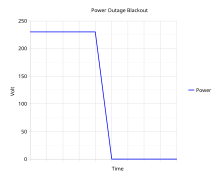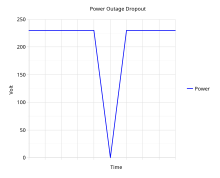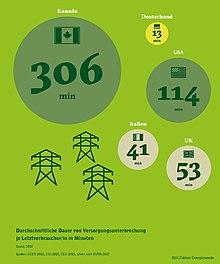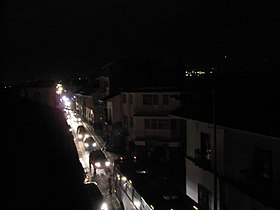Electrical blackout
A power outage or power outage is the loss of power to an area.
The causes for the supply drop will normally be the failure of one of the elements that make up the electrical supply system, for example, a defect in the electrical substation, damage to a power line (accidental or intentional, as in the case of cable theft, sabotage actions by private groups), or in another part of the transportation system or the distribution system, a short circuit, an overload, the deficiency or obsolescence of the electrical transportation or distribution system, lack maintenance and even a human error in the operation on elements of the system. It also usually occurs in eventual unforeseeable conditions: climatic rigors such as storms (trees falling due to cables, damage to transformers, or blackouts for safety), heat or cold waves (use of air conditioners or heating systems at maximum power), earthquakes or landslides, tsunamis, among others.
A blackout can also be caused by excess consumption, which is aggravated if the electrical network is not fully developed. In other words, even if a sufficient amount of energy is produced to supply said consumption, if there is no network capable of transporting/distributing and delivering the energy to the end user, a blackout will occur.
Blackouts in underdeveloped countries
Electrical blackouts are common in some underdeveloped countries, especially in Africa, because they do not have an efficient electrical generation/transportation/distribution system, mainly for cost and financial reasons. Most electricity generating plants work with oil derivatives that must be purchased in millions of dollars from countries that export and refine this raw material. In addition to this, they must be transported by sea, which may suffer delays due to storms or other reasons. It is also attributed to the fact that generally, during heat waves, air conditioners are used at maximum power, which causes overloads in the deficient electrical distribution system in these countries.
Underdeveloped countries have no way to compensate the balance of payments, since they do not have a solid source of foreign exchange income, which generates a costly electricity bill for end users that many cannot sustain, mainly the class low population and small businesses. This situation produces constant power blackouts in different areas of the nation to cover the collection deficit and ration the service, but this measure motivates more sectors of the population to join in not paying for an inefficient service (constant blackouts) and at a high price..
The governments of these nations have tried to mediate the problem by promoting the efficiency of service collections and the search for electricity generation with renewable energy, but the constant rise in the price of oil and the lack of strong political will submerge these countries in an almost endless problem.
Famous Blackouts
The electrical blackouts that have affected the most inhabitants have been:
India – 700 million people affected (July 31, 2012)
The worst power blackout in recent history occurred in northern India for two consecutive days in July 2012. Specifically, the first blackout occurred on July 30 in the northern grid, affecting 300 million people in nine states, including India's capital region, New Delhi. However, not everything ended there, a larger blackout occurred again the next day, affecting the networks of the North, West, East and Northeast, affecting a total of 700 million people in 20 states of India.
An over-demand for electricity by certain states and weak power transmission corridors between regions were cited as the main reasons behind the blackout. The incidents caused trains to suspend their services and traffic lights to stop working, generating multiple traffic jams. Surgical operations were canceled and construction and mining work was halted throughout the northern region of the country.
India – 230 million people affected (January 2, 2001)
India witnessed another power blackout on January 2, 2001, due to the collapse of the Northern grid, affecting some 230 million Indians who depended on the second largest interconnected grid in the country.
The failure of a substation in the state of Uttar Pradesh caused the collapse, while poor and inadequate transmission equipment also contributed to the cause of the blackout. More than 80 trains were blocked in the region, suspending other commercial activities and services. The network took 16 to 20 hours to restore, causing an estimated loss of up to Rs 5000 crore.
Java and Bali, Indonesia – 120 million people affected (August 18, 2005)
A major power outage occurred across the Indonesian islands of Java and Bali in August 2005, affecting 120 million people, or nearly half the country's population. The capital city Jakarta and its neighboring province of Banten were in complete blackout, with parts of West Java, Central Java and East Java also experiencing blackouts.
The Java-Bali power grid, which had an installed capacity of 19,615 MW, collapsed due to a failure of a 500 kV transmission line between Cilegon and Saguling in West Java. Transportation services were disrupted and a number of domestic and international flights were delayed or canceled due to the blackout. The system's network was, however, fully restored within 24 hours.
South and Southeast of Brazil – 97 million people affected (March 11-June 22, 1999)
Approximately 97 million people were left in the dark throughout the south and southeast of Brazil from March to June 1999, after lightning struck an electrical substation in São Paulo. The incident caused a chain reaction that resulted in the closure of Itaipu, one of the largest hydroelectric plants in the world.
The power blackout, which lasted for five hours, paralyzed São Paulo and Rio de Janeiro, two of the largest cities in Brazil. Approximately 60,000 people were trapped in Rio's underground metro. To prevent looting and assaults, 1,200 military police officers were deployed in Rio and the tunnels in the city of São Paulo were closed. On June 22, electricity returned and was fully restored.
Brazil and Paraguay – 67 million people affected (November 10 - 20, 2009)
Major areas of Brazil and the whole of Paraguay were left in the dark for two to four hours on November 10, 2009, when strong winds and torrential rains shorted three transformers on a high-speed transmission line. voltage, which affected a total of 67 million people.
Six states in central and southern Brazil, including the cities of Rio de Janeiro and São Paulo, were left in total darkness, ultimately leading to the stoppage of the Itaipu hydroelectric dam after the connection lines to the plant fell. The dam, which is located on the Paraguay-Brazil border, stopped producing 18,000 MW of electricity, affecting both countries. A number of traffic accidents were also reported during the blackout due to the lack of public lighting.
Italy – 57 million people affected (September 28, 2003)
Italy experienced a blackout on September 28, 2003 after a high-voltage line supplying electricity from Switzerland was damaged by a series of fallen trees during a storm. The incident occurred around 3:00 a.m. m. (local time), affecting almost all of the 57 million Italian population. It also caused the interruption of the service of 110 trains carrying more than 30,000 passengers in Italy, while the trains held up at the border with Switzerland were stopped for more than 4 hours.
The Swiss region of Canton experienced three hours of power outages while Rome was hit the hardest, as the blackout occurred during 'White Night', an arts festival held at night. About 90% of power was restored after eight hours, although some regions took up to 18 hours to get power back on.
Northeast United States and Canada – 50 million people affected (August 14 - 28, 2003)
Approximately 50 million people were affected across southeastern Canada and eight states in the northeastern United States in a blackout that occurred in August 2003. The power outage lasted 2 days and cost $6,000 million dollars in damages, for what is currently the worst power blackout in North American history.
The outage occurred when a high-voltage power line in northern Ohio went offline after coming into contact with trees that had not been trimmed. FirstEnergy Corporation's faulty alarm system failed to alert operators, leading to a domino effect that resulted in the shutdown of another three lines. Following the incident, a joint task force was created between the US and Canada to prevent future blackouts caused by similar circumstances, fully restored to 14 days.
Northeastern United States and Northern Canada – 30 million people affected (November 9, 1965)
A power outage that occurred during rush hour in parts of Canada and several northeastern United States on November 9, 1965, lasted for approximately 13 hours, affecting more than 30 million people in New Jersey, Connecticut, Massachusetts, Rhode Island, New Hampshire, Vermont, Quebec, and Ontario.
The power outage was caused by a faulty or improperly adjusted safety device at the Sir Adam Beck station on the Ontario side of Niagara Falls, which resulted in the disconnection of a 230-meter transmission line. kV, producing a domino effect. The event left nearly 800,000 people trapped in the New York subway. To prevent looting and vandalism, 5,000 off-duty police officers and 10,000 National Guard soldiers were called to duty. The blackout, which occurred during a full moon, thankfully ended without incident.
New York, USA – 9 million people affected (July 13-14, 1977)
Lightning caused a blackout in New York City on July 13 and 14, 1977. The Indian Point nuclear plant had to be shut down, while a second lightning strike caused two 345 kV transmission lines to shut down.
The subsequent surge, along with malfunctioning security equipment and various human errors, left nine million residents without power for nearly 24 hours. This time, the blackout led to massive looting throughout the city, with approximately 1,600 shops damaged and 1,000 fires set by vandals. This event led to the largest mass arrest in the city's history, around 3,776 people in a single night.
Quebec, Canada – 6 million people affected (March 13, 1989)
The entire province of Quebec, Canada, suffered a 12-hour blackout on March 13, 1989. A solar geomagnetic storm was responsible for the collapse of Hydro-Québec's electrical power transmission system, leading to a blackout that affected six million people.
The geomagnetic storm caused a variation in the earth's magnetic field, damaging the Hydro-Québec electrical grid. The Montreal Metro and Dorval Airport were forced to temporarily suspend operations, while schools, businesses and commercial services were closed during the blackout.
Venezuela – 31.5 million people affected (March 7 - December 31, 2019)
On Thursday, March 7, there was a large blackout, which initially affected 15 of the 23 states of the country and later it was known that it affected 22 of the 23 states, including the Capital District for around 15 hours due to a failure originated in the Simón Bolívar Hydroelectric Power Plant. During March 8, the electrical situation remained intermittent, some states such as Zulia, Barinas, Carabobo, Lara and Mérida remained without any electricity.
At dawn on March 9, the second blackout came in just 2 days. The latter was in the 23 states, including the Capital District, for around 14 hours. Until now the electrical problem continues intermittently, in states such as Zulia, its 4 million inhabitants have remained without electricity for around 120 hours, this has caused demonstrations along with acts of vandalism (looting), being the largest electrical blackout that occurred in the In the history of Venezuela, on December 31, electricity returned and was fully restored.
Argentina / Uruguay / Paraguay – 50 million people affected (June 16, 2019)
On Sunday, June 16, 2019, there was a power cut that for the first time affected all of Argentina (except Tierra del Fuego), Uruguay and some areas in Paraguay, starting at 7:08 in the morning. Among the causes of the incident are an overload of energy in the transmission lines that connect the network with the Yacyretá and Salto Grande hydroelectric plants, which provide the country with the most energy, and a technical failure in the protectors, which should have encapsulated the cut to the coastal zone. The main hypothesis of the analysts of the sector is that the storms of the coast removed from the system the lines coming from Yacyretá and Salto Grande. "This takes power plants throughout the country out of synchronism, which have automatic protection when the 50 Hz frequency is altered. Since Uruguay is connected to Salto Grande, that country was also affected" , they explained.[citation needed]
Table by number of people affected
| Article | Affected (millions) | Location | Duration | References |
|---|---|---|---|---|
| Java and Bali Out of 2005 | 100 | Indonesia | 18-08-2005 | |
| Apagón de Brasil y Paraguay de 1999 | 76 | Brazil and Paraguay | 11-03-1999/22-06-1999 | |
| Brazil and Paraguay blackout 2009 | 60 | Brazil and Paraguay | 10-11-2009/20-11-2009 | |
| 2003 Italian blackout | 55 | Italy | 28-09-2003 | |
| 2003 North American blackout | 55 | Northeast America (Canada, United States) | 14-08-2003/28-08-2003 | |
| Apagón de Argentina, Paraguay y Uruguay de 2019 | 50 | Argentina (except Tierra del Fuego), Uruguay and 2 departments in Paraguay | 16-06-2019 | |
| Apagon of North America of 1965 | 40 | Northeast America | 09-11-1965 | |
| Apagón de Venezuela de 2019 | 31.5 | Venezuela | 07-03-2019/31-12-2019 |
Contenido relacionado
Wire
Electronics
C++





